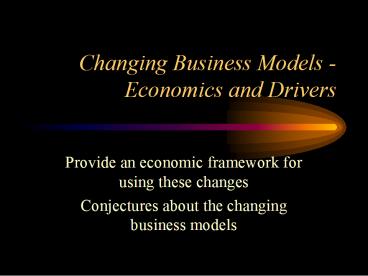Changing Business Models Economics and Drivers - PowerPoint PPT Presentation
1 / 31
Title:
Changing Business Models Economics and Drivers
Description:
People search until it is no longer worth the effort. Easy to find sites have an advantage. Advantage to search aids, banners, etc. ... – PowerPoint PPT presentation
Number of Views:53
Avg rating:3.0/5.0
Title: Changing Business Models Economics and Drivers
1
Changing Business Models - Economics and Drivers
- Provide an economic framework for using these
changes - Conjectures about the changing business models
2
Economic Background
3
Areas Impacted
- Search costs
- Information imperfections
- Bundling
- Network externalities
4
Search Costs
- View searching as a capital budgeting decision
- People search until it is no longer worth the
effort - Easy to find sites have an advantage
- Advantage to search aids, banners, etc.
- Advantage to adding products to desired targets
(thus reducing search costs)
5
Information Imperfections
- Vendors make artificial profits because of
imperfect information - Another way of looking at search costs
- Web reduces profits by
- Facilitating searches
- Use of intelligent agents
- Need to build other information and
non-information imperfections
6
Bundling (Bakos/Brynjolfsson)
- Vendors make artificial profits by bundling
desired and undesired products - Another way of looking at search costs
- Web impact uncertain
- Relate to search costs
7
Findings
- Multi-product monopolists get higher profits by
offering a single bundle of information goods - Bundling captures customers who might otherwise
avoid some products - Mixed bundling increases sellers profits if
seller can enforce a bundle price greater than
the sum of the components
8
Empirical Evidence - Alternative Approaches Found
- AOL, Reuters bundle large sets of goods
- What will AOL/TW do?
9
Empirical Evidence - Cable and Direct Satellite
- Base vs. Premium vs. Pay-Per-View
10
Empirical Evidence - Microsoft
- Suites
- Incorporate functionality from other firms in its
operating systems - Internet Explorer
11
The Information Superhighway -- A Network
12
Components
- Complementary -- not substitutes
- Compatible -- can be combined to produce demanded
goods - Compatibility may be either inherent or the
result of technical compatibility standards
13
Compatibility -- Illustrations
- ATT prior to the breakup
- IBM in the 80s
14
Network Externalities
- Value of a unit of goods increases with the
expected number of units sold. - Sources
- Extra customer of telephone services increases
value to all - Availability of a broker increases both buyer and
seller value - Larger market size impacts both price and risk
15
Network Externality Implications
- Shift from normal concept of supply and demand
- Focus is on expectations of other peoples
behavior - What is the value of a fax machine?
- Potential for predatory profits
- Issues and concerns
- Anderson consulting Bargainfinder to find CDs
- Participating sellers dropped out or made it
harder to search - Airline industry - complex fares and frequent
traveler programs raise search costs and increase
cost of change
16
Network Externality Implications - More
- Firm has higher profits if its standards get
adopted - Compatibility is a strategic decision
- If incompatibility -- loss of profits is higher
since systems (rather than component) sales are
lost - Profit more responsive to price
17
Managing the Competitive Environment
- Technology and costs make it possible for anyone
to establish electronic markets - Sellers can lock out competition by creating
their own intermediaries - Amazon.com
- Charge for price information
- Airlines -- easy flight information, hard to find
lowest cost
18
Additional Strategies
- Sellers control type of system introduced
- Emphasize product over price information
- Increasingly difficult price comparisons
- Airline fares, restrictions, ticket availability
- Differentiate commodity products
- Frequent travelers programs
19
Research Agenda
- Role of buyer heterogeneity
- Impact of buyers who have search systems on
buyers who do not - focus on search cost of sellers to find buyers
- Multi-period models -- role of history,
reputation, lock-in, installed base, customer
loyalty, knowledge about customers
20
Standards Provide
- Ease of market entry
- Basis for reliance
- New and related products
- Basis for
- Network externalities
- Lower costs
- Bundling
21
Key Assets to Manage
- Control over installed base
- Intellectual property rights
- Ability to innovate
- First mover advantages
- Strength of complementary products
- Reputation
22
The Message
23
Focus on the Network
- Look for network externalities
- Look of virus-like applications
- More begets more begets..
24
Evaluate the Lock-In Factors
- Linked applications
- High switching costs
- Personalization
25
Make Effective Use of Versioning
- Migrate users
- Lock in
- Razor blade strategy
- Basis for bundling
26
Buyer Management of Lock-In
- Bargain at the outset
- Minimize switching costs
- Keep options open
- Avoid monopolistic exploitation later
- Avoid creeping lock-in
27
Seller Management of Lock-In
- Seek buyers with high switching costs
- Seek influential customers
- Build multiplayer strategies
- Sell lists to others (network externalities)
- Build loyalty programs, e.g., frequent traveler
28
(No Transcript)
29
The Business Model Changes
30
From Publishing
- Sales of banner space
31
To Traditional Business (Enhanced by Web
Characteristics
- End-to-End Control
- Category Killer
- Portal
- .































